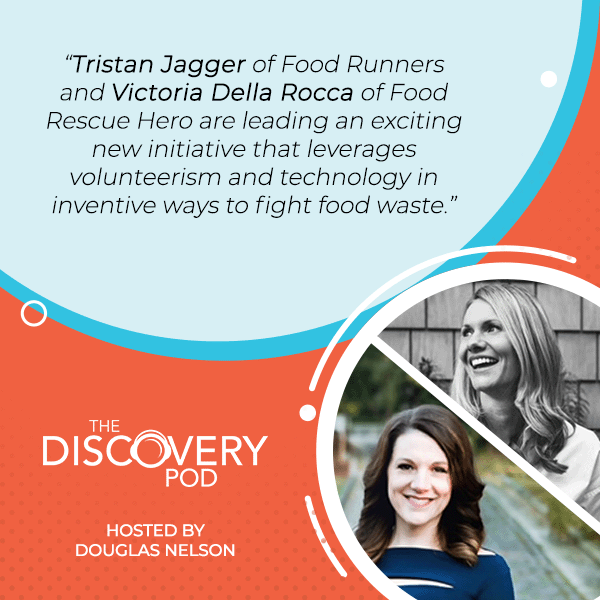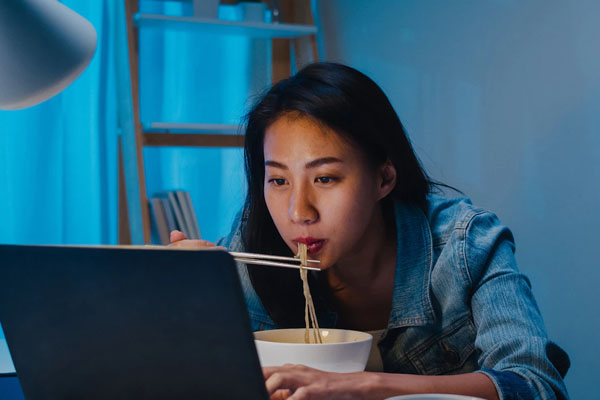
Over 30% of food is lost or wasted each year, which is striking, given the large number of hungry people worldwide. This wasted resource is a social justice issue that we should mitigate. In this episode, Tristan Jagger of Food Runners and Victoria Della Rocca of Food Rescue Hero share their insights on how these organizations help control the issue of food waste. The technology behind Food Runners and Food Rescue Hero has made a great deal of impact in engaging volunteers and holding onto them. This episode is an exciting way to approach engaging the next generation and volunteerism, and there’s much to learn in this conversation. So take the path to help mitigate food waste by tuning in to this episode to learn more!
—
Listen to the podcast here
Vancouver Food Runners & Food Rescue Hero
In this episode, we have two exciting guests from two exceptional organizations dealing with the issue of food insecurity and food delivery across North America and beyond. Our first guest is Tristan Jagger. She’s the Founder of Vancouver Food Runners. We’re also joined by Victoria Della Rocca, who’s the National Strategic Partnership Lead for Food Rescue Hero.
In our conversation, we learn about this exciting new technology that’s delivering millions of pounds of food on a monthly basis to those in need, addressing more than 10,000 people every month in Vancouver alone. Learn about how their volunteer engagement strategy has lowered the barrier and streams of volunteers have come in to help address this issue in Vancouver and well beyond. It’s an exciting way to approach engaging the next generation and volunteerism. There’s a lot to learn from this conversation. Please enjoy.
—
In this episode, we have two guests from two different organizations who are collectively working to reduce food waste while also providing food for those who can’t afford it. They’re tackling societal issues through the advancement and application of technology. Welcome, Tristan and Victoria.
Thanks for having us.
Victoria, as we started in the introduction, there is an app for this. Food Rescue Hero was founded in 2016. Since then, you’ve expanded into fourteen cities rescuing more than 100 million pounds of good food from landfills and giving it to people who need it the most. Where did the idea for Food Rescue come from? Tell us a little bit about the technology behind it.
A lot of what we’ve seen in each of the cities that we now work with is this idea of how is food insecurity and the need for more food alongside this massive amount of food waste happen. It’s this broken equation that makes no sense to any of us. How do we do something reasonable in our everyday life that could make a huge impact on this? Leah Lizarondo and the 412 Food Rescue crew got together and looked at, “How can we make this transition here in Pittsburgh? What is that going to look like?” Within the Food Rescue Organization, they started simply finding surplus food opportunities and bringing it to places they could be most utilized and used.
As that started to happen, they realized this was very difficult to do on Excel spreadsheets and Google Sheets and trying to manage where volunteers go and how they do this seamlessly and safely. That was where the technology came from and the idea of mobilizing a group of individuals in a way that feels manageable. This works a lot like Uber or any of the other ride-share programs. It’s like a food rescue that sends a push notification to volunteers to say, “Pick this up. This is ready to go,” and the volunteer transports it directly to those who could benefit most from it.
That’s an incredible concept and idea. I’m curious how the first few steps of that worked as the app rolled out. What were some of the lessons that you learned right out of the gate?
In my role as the Strategic Partnership Lead, it was exciting to work alongside both Leah and Jen, who helped launch it in the Pittsburgh area. For me, being able to start something brand new, they were already to scale, doing big things in Pittsburgh, and doing exciting things. Trying to build that in a new city was exciting, but we learned very early on that it is gritty and difficult work when trying to move things in real-time. Things will come up very quickly.
We do anything we can do that helps anticipate what is coming and strengthen the network as a whole by amplifying the use of technology, which helps with real-time safety tracking, data, understanding what impact we’re having, and where we’re having that impact. Certainly, it makes a huge difference in getting so many individuals involved. We have over 30,000 volunteers across our network who are doing regular rescues and actively involved in preventing food waste but also making sure that food gets to those who would benefit the most.
Tristan, turning to you now, you founded Vancouver Food Runners in 2020. You were the first organization outside the United States to be using the Food Rescue Hero technology. How did you first become aware of the need for this issue? What drove you to connect with the app?
Back in 2019, I was a mom of three young kids. I discovered that in Vancouver, 1 in 6 kids go to school hungry. There’s 1 in 6 kids hungry in Vancouver. For me, I couldn’t believe it. It was such a shocking statistic for me, so I literally got into my computer and started googling like, “What are other people doing in North America and the world trying to combat food insecurity?” I came across this amazing woman in San Francisco. Her name was Mary Risley. She had started Food Runners there many years ago. I called her out of the blue.
In my mind, Francisco and Vancouver have a lot of similarities, so I was like, “This is the lady I need to talk to.” She finally picked up the phone. She’s 85 years old, and she’s still doing it. She said to me, “You’re not speaking my language, but I know somebody that can help you. You two could connect.” She put Leah Lizarondo and me in touch, the Founder of 412 Food Rescue and the app. She said, “You two are going to fly down to San Francisco and meet.” I was like, “Okay.” I didn’t have a nonprofit. I had nothing. All I had was this idea. I flew down, and Leah was there for the conference. I made her meet me, and I convinced her. I said, “You need to give me this app, and I’m bringing it to Canada.”
Leah had 1,000 questions like, “How are you going to do that? You don’t have a charity number. What are you doing?” I said, “Trust me. I’m going to pull this off.” I got back to Canada. She said, “Fine, let’s do it.” I was like, “Let’s go for this.” At that point, I started interviewing different restaurateurs and catering companies in Vancouver, seeing if this was even going to work. I’m like, “Do they have leftover food? How much leftover food did they have?” I started meeting with some of the nonprofits. I’ve been working in nonprofits my entire career, so I started meeting with people I knew already, thinking like, “Would this be something that would work?”
What I found out this app could offer that is such an asset to Vancouver was that we had organizations in Vancouver that could match the food. The issue is there was nothing that was tech and could have volunteers pick up the food. It could take out the middleman. The big important piece of this is that we can run so lean because the technology does so much, and we can cover a lot of ground.
As soon as I started selling that story to all these people like, “The chef at YWCA doesn’t have to actually drive and get the food from Safeway,” that was such a huge selling feature. It was like, “We’re going to have a volunteer go at this time or whenever it’s available. We’re going to drop that food for you.” That became such an important part of the piece of the puzzle for people to finally say, “Let’s give Food Runners a chance.” Slowly, we grew and grew.
It’s the ideal disruption in our sector. A lot of food distribution organizations have their distribution centers. They’ve got the community hubs that they run, which all have value and a place, but they end up being these huge costs for these organizations, let alone the running the trucks and the drivers and the gas and all that. One of the things that were appealing to me when I came across the organization was this unique way of delivering this.
It addresses a lot of the needs that we’ve seen through our work with clients over the last number of years to just, “We’ll look after it for you in a way that empowers volunteers in a special way.” It’s a brand-new idea. I’m sure it was very smooth, with no pushback. Everybody said, “This is great. Let’s get right on with it.” I’ll ask you first, Victoria. It’s gone into different cities in the United States and around the world now. Are there common themes to the kinds of resistance or the barriers that new versions of the program face?
We are seeing both the positive and negative sides as far as both unique challenges as well as incredible advantages to something that can be scaled internationally, which Tristan said so well, in such a very accessible way. You have something that everyone’s a part of, like neighbors feeding neighbors. The idea that you can directly connect food from a local source is not going somewhere else, but you are mobilizing that. Looking at the new organizations that have brought this on, it has been unique. Philly is different than California, that’s different than Vancouver. We see that some people love the idea of adopting technology.
For other people, that’s a shift for them. The idea of utilizing an app to move food can be different for nonprofits. Some of it is making sure you’re bringing everyone along on that. We also have done a lot internally to support each of the organizations. One of the exciting things for us was in 2021, we launched what’s called Food Rescue University, which is a learning management system where we coach every step of the way, both the use of the technology and possible challenges that might be faced. Those challenges might find a digital divide.

Food Waste: Food Rescue University is a learning management system where we coach every step of the way, both the use of technology and possible challenges that we might face.
Sometimes it can come down to where we find a challenge where in certain locations, food procurement, making sure they understand that it’s safe. To Tristan’s point, sometimes it’s an easy sell because they want to be doing these things. Other times, it’s something they have never done before. They’re learning for the first time the idea of this is safe and reliable. The fact that we offer a 99% reliability rate, which beats Uber Eats in their percentages, and we use a volunteer base is exciting for us. Those are things that sometimes are coachable and talkable moments about the challenges we often foresee in various markets.
Tristan, you talked a little bit about the conversations with chefs and people at Safeway and getting them to deliver that. I’m curious about what other potential barriers you initially experienced. There is a fair bit of disruption to existing organizations involved in this app. I’d love to know how those first conversations went.
There were two kinds of barriers. One was food safety. “You’re going to go send these volunteers. Can we guarantee the food is going to be fresh?” That’s all been figured out by the government. That’s all been cleared. Nobody that ever gives food in good faith would ever be charged for anything. That was clear. How do we prove it? We can track our driver. We know the volunteer picks up the food and knows how long that food is in that car. That was one thing they started to be like, “That’s interesting.” The volunteer’s not stopping for two hours before the food gets dropped off. No. We usually try and match the food with the nonprofit within ten minutes of each other. It’s like going to the grocery store and taking our food home. That was a big one.
Another thing that I would say is for a lot of food suppliers, it takes a lot of effort and work on packaging up the food and get it organized. They felt a bit burned many times like, “No one even showed up. That’s so frustrating.” Before this app, in other organizations, after a catering event or something, they’re calling all these nonprofits in Vancouver to see if they could drop off the food or if someone could come to pick it up. It was such a hassle for so many of them. They didn’t understand that, “This could work. This is the solution.” It took a bit of a few times. As they were saying, it’s amazing. It’s a 99% success rate in pickup.
It takes a lot of effort and work to pack up the food and organize it. Share on XThat’s the same for Vancouver Food Runners. I don’t think we’ve ever missed a pickup. As our name started getting stronger and stronger in Vancouver, everyone was like, “They’re always there.” That was a big relief for our food suppliers. Also, what we’re a huge value in Vancouver Food Runners is that we work with 160 different nonprofits in Vancouver. We know exactly what food they can take in. Some nonprofits have a fridge. That’s all they have, so they can take this. Some have chefs, so they can take raw fish, raw chicken, that kind of thing. We know what everyone’s serving, what mealtime they serve at, and how many people they serve. It’s like this giant map of food in Vancouver.
We’re the ones who have that knowledge. It’s such a big piece of the puzzle. For us, when a food supplier calls us and says they have this food available, we know exactly who can take it at what times of the day and who needs it that day or tomorrow, which was a bit of the piece of the puzzle that was missing. A lot of times, people were calling at 10:00 at night or 8:00 in the morning, and people were trying to find someone to take the food, but if you don’t know what a nonprofit can accept, it’s a bit of a mystery to everybody.
Are nonprofits the primary groups that are receiving the deliveries?
Yes, all the big ones, everyone basically in Vancouver, honestly. It’s 160 now. We just started and grew.
One of the biggest challenges that we hear from a lot of large, long-established organizations that rely on volunteers is that people don’t want to volunteer anymore. It’s very difficult to engage volunteers and hold onto volunteers. You have a goal to increase your volunteer team by an additional 500, bringing it to 2,500 Food Rescue Heroes in the lower mainland. How have you managed to attract such an impressive number of volunteers in such a short period of time? How do you manage so many volunteers?
That’s the beauty of this technology. The biggest selling point for me about this app, which is an incredible feature, is the volunteer side of things. Vancouver Food Runners and 412 Food Rescue is a modern version of volunteering. Not everybody wants a schedule, “Every Tuesday at 9:00 AM, I’m going here.” Everyone’s life is so chaotic. They need to have flexibility. This is what’s so amazing about it. You get this push notification in your phone at 10:00 on a Wednesday, “I’m in Downtown today. Great. I’m going to do that. That’s a feel-good thing for me. I’m going to accept that food rescue.”

Food Waste: Everyone’s life is so chaotic, and we need to have flexibility.
You don’t have to come back and do it ever again if you don’t want to. You could come back in a month or the next day. It doesn’t matter. We also have the ability to do weekly food rescues where we know Terra Breads, for example, gives bread every day at 4:00 PM so we can set up volunteers throughout the week. Some people like that as well, but there are options. It’s a low barrier to entry, and it’s a fast process. You’re door-to-door for one hour, and that would be the max time. You get to see both sides. You see all the food that’s going to go to waste, and you put it in your car. It’s like the best feeling in the world, and you drive it to the nonprofit. You see where it’s going.
It’s a nice feeling to be able to give it to people that need it. It’s got both sides to it. We have a lot of returning people. We have had people that have done 500 food rescues. We have this guy named Tim King. We call him The King. He’s amazing. He picks up in his pickup truck food every second day. He’s a retired guy that used to work in the corporate world. He’s like, “This is what I want to do.” This kind of people come into the platform, and it’s been honestly incredible to see. We average it out. It’s about $450 on average worth of food per food rescue. That’s a lot of food. That’s a good feeling when that’s just free in the back of your car.
You’re also delivering it to people who need it.
People really like that feeling, and the flexibility of it is a huge asset. It’s all in the app, like if you don’t want to talk to anybody. Nobody likes to talk anymore. Everybody wants to text. That’s the part of the world that we’re going into. They don’t want to talk to somebody on the phone, let’s just say. They want to look at their app. All the information is there. They don’t have to do anything except the food run. It gives you all the directions to get there, who to talk to when they get there, they drop the food, and they’re gone. That’s it. It’s simple.
It’s a modern solution to the current problem of encouraging volunteerism across the social profit sector. I can see the appeal. Shout out to Tim, the King. Victoria, Food Rescue Hero has a goal of being in 100 cities by 2030. Based on this conversation and what we’ve learned about the organization as we got ready for this conversation, I have no doubt that you’ll be able to reach that goal. How does an organization sustain this hyper-growth and not compromise on service, delivery, or the brand you’re building?
That was important from the beginning because 412 Food Rescue, even with its name, is clearly local. It’s a very Pittsburgh solution. When the technology was built, we realized that there are Tristans out there. For me, there’s the Philly version of this, and there’s the California version. Early on, we felt this needed to be a scalable, reasonable, realistic solution with strong data that gave us a lot of that ability to have those core pieces. Those core pieces are there because it was built in food rescue. As that was happening, and we were all on Google Sheets and trying to figure out how to do this, it started to build from that place. This isn’t external group thinking. This is a nice idea. This is built from necessity.
It is also being informed and continuing to be built by so much of the feedback from each of the city partners. Now, this has become an international solution with local drivers. This is very much Vancouver’s story and how that’s local and unique to them. What is exciting about it is that it helps us scale this whole concept of what this would look like, how we put those pieces together, and how they are going to be standardized but also very local. The thing that you mentioned earlier about being disruptive is very real. We also see that as a great advantage in the sense that we’re the and not the or.
There’s a lot that’s been happening that’s good, to your point. What we’re seeing is, “Can we take fresh food that is ready to go?” Eighty-seven percent of our food is fresh food, which is the highest need for food security. Looking at food that is going to be viable, only 15% of foods that are donated are fresh. We think about the nutrition content and the difference between what’s shelf stable and what is this fresh food that’s now available.
Our distribution model is unique because although we are often working with nonprofits and organizations, we’re also looking at making food within reach. We go beyond the food pantry system. Many of our partners are working with the housing authority. They’re working with low-income housing senior centers, programs helping with daycares, and others. This makes it a dignified and amazing way of receiving food that is part of everyday life. Because the model itself has scalability, it stood the test of multiple cities and scaling to those organizations.

Food Waste: The distribution model is unique because we are targeting, although we often work with non-profits and organizations, we’re also looking at making food within reach. So we go beyond the food pantry system.
That’s compelling. I’m excited. I don’t have a pickup truck, but I want one now.You don’t need one.What do you need?
Anything.
A bike. That’s the truth. What’s so cool about this is that the app tells you exactly what’s available. It could be a box of food. You could accept that one, not one with twenty boxes, if you don’t have a pickup truck. To be honest, that’s what we were filling the void in Vancouver. They have a lot of organizations that have big refrigerated trucks that can go around and pick up crates and crates of food, but that’s not our model. We’re trying to get to the place where we’re picking up even three boxes of food and taking it. That’s what was missing.
You identified the gap, and you’re filling that gap. Anyone who’s been to a grocery store knows that the price of food, particularly fresh food, is going up at an alarming rate, which creates even greater scarcity for those that don’t have access to it. As your organization is growing, have you seen the impacts of what inflation is meant for families and organizations?
Absolutely. When we talk to our nonprofits and stuff, the food that we’re able to rescue and bring to them allows them to continue on their food programs because so much has been cut. Even during COVID, there was so much funding for food programs. That’s faded away, even though food prices have increased so much. We can pull numbers because we can track all the food that’s going to all of our nonprofits.
This 2022, we saved the YWCA $123,000 in food costs. They can put that money back into programming. That’s their sole job. Their sole job wasn’t just to feed people. They do a whole bunch of different things. Those numbers are what I love. You can see the amount of money you’re saving them by bringing them food. Food prices are increasing so much, and it is a way we can bring people good quality food. That’s a great feeling.
It’s remarkable that you have, on the one hand, the story of disruption. I think of disruption in positive way in changing the way the game is played and changing the food distribution system very positive. That disruption, which does change the business models of other organizations, has been in food distribution and redistribution. So much of what you’re describing seems to rely on collaborations with the organizations you’re working with. How do you balance that, “We’ve got a new way, and it’s totally different, and we all have to work together?” I can imagine some conversations where there is some healthy tension.
We’ve been pretty lucky in the way that this model of picking up small amounts of food in Vancouver was just not there. If it were there, it was not an organized system. It was people volunteering at an organization. They would go pick up food here and there. We’ve been able to call up those places. If they had a volunteer going to pick up something on Tuesday from Safeway, we could now put that volunteer on our app. We can be of service to them in that way. Also, we work with other big organizations in Vancouver, like Food Stash. They have big trucks on the road. We work in partnership where they get a call where a coffee shop has a whole bunch of cinnamon bun. They’re not going to send a paid driver to pick up that.
They’ll call us right away. It’s the same thing like if we get a call from somewhere in Burnaby that has a huge crate of food that’s been brought off or can’t sell or something, we’ll call them and say, “You need to send your truck there and get it.” We have worked in partnership, and it is taking a bit of time to build up our name like, “Who are these people? She just caught this app. She doesn’t even have a charity.” After a few years, we’ve proven ourselves and now have a charity number. We are part of the food system in Vancouver. There were amazing people here before, and it’s figuring out how to work together.
I would think that delivering more than a million pounds of food and touching 10,000 people a month, some legitimacy and credibility might come along with that track record. Two thousand volunteers is another impressive thing. Victoria, you talked a little bit about the potential for a global scale and the importance of local involvement and connection. What do you see as the greatest opportunity for this technology and this movement in general over the next couple of years?
There’s that idea of the broken equation where we have two very big problems that there are not very clear solutions to. I’ll go beyond the idea of food insecurity and take that to nutrition insecurity, which is that not only are we not really meeting the needs of hunger in our community, but we’re not meeting the nutrients that any community members need to help combat long term comorbidities like heart disease and a lot of the diet-related diseases that are highly correlated with a lot of the foods that unfortunately are easiest to distribute and are more shelf stable.
What we find is redirecting that surplus food takes it out of the waste system, which is so hugely important to the climate change impact, and looking at how food waste can be a major contributor to greenhouse gases. We look at both of those things holding at the same time. When we think about that being able to respond to the SDG target of 12.3 to half per cap of food waste by 2030 directly with also leveling SDG 2 with zero hunger, we look at this idea of, “This could be a very reasonable way of making that change by scaling this in multiple places.”
By redirecting surplus food, that takes it out of the waste system, which is hugely important to the impact of climate change. Share on XAt its core, it’s the neighbors that are making the difference. When we have a local solution, it’s so empowering for city members and also an individual. I teach a Pilates class and run a rescue right afterward. It takes me twenty minutes out of my day. We say, “How can you do good in your every day in a way that feels reasonable?” To Tristan’s point, most of us don’t have a whole day or even chunks of time that we can give to what we want to be doing. How can we make doing good in everyday experience to that you can impact two of the major development goals? That’s where we see this going.
That sounds wonderful. This would be a longer Tim Ferris-length version interview. The number of organizations through our work here at the show, there are a number of organizations that are guided by the SDGs. One of the things they struggle with sometimes is translating that into action. The sustainable development goals are so big picture at scale meta-level things that the work that happens on a day-to-day basis can be very difficult to connect to the work of the organizations. They spend a lot of time focused on the storytelling of connecting those two.
Food waste can be a major contributor to greenhouse gases. Share on XWith this technology, it seems intuitive what that connection is, that connection to the goal and the action that you’re taking in twenty minutes or an hour. It gets compelling when we talk about how we get young people involved in the social profit sector and engaged in community service. It seems like you, both by track record and potential, got something important here. When people read this episode, they’re going to think as I do, “How do I get to be a part of it?” How can people join you in your team in Vancouver to make a difference on a daily basis?
It’s super simple. The good thing about this is that you download the app Vancouver Food Runners. You answer two questions, fill in your phone number, and right there, you can see what food runs are available now and tomorrow. We put them up leading up to three days out so people can see what’s available. They can accept one now.
I’m going to ask the question because our readers are probably thinking about it, and I know you’ve got a good answer to it. If it’s only two questions to sign up, people pick up the box of food and say, “This looks pretty good. I’m going to take it home.”
It’s a few more than two, but it’s not many. After you do two food rescues, we have a little quiz that you have to answer, but it’s super simple. It’s nothing much, but it’s to tell you a little bit about what to make you look out for. Also, our food suppliers know what we can accept. The food is always the highest quality, so we’ve never had any issues like that.
That’s great. It’s a low barrier to getting involved but a high expectation of service delivery once people are involved with it, which is great. I’m going to end my favorite last question for both of you. I’ll start with Victoria. What are you most looking forward to?
What we have been excited about is this October 2022, we had the opportunity to have our first national and international food rescue conference. All of us gathered together to have the opportunity and live streamed the entire conference to gather best practices and grow in our knowledge and understanding of each other. We are all going after this together. All of us are passionate people.
I’m a mom of four. I do the same story. We have busy lives. We have a lot going on. How can we make this reasonable? How can we see this change? The thing that’s been most exciting is getting to watch what unique pieces come together as this very diverse group and locations are finding solutions locally that could be scaled internationally. For us, it’s seeing the momentum build. I’m excited to see what 2030 looks like.
Tristan, how about you? What are you looking forward to?
What excites me about this and keeps me going and motivated to keep growing Vancouver Food Runners is seeing how many people care. I know that sounds crazy, but it’s true. All of a sudden, now, after two years, we have 2,500 drivers driving food. How many more can we get? Let’s just get 5,000. It would be so exciting to have all these people driving food that would’ve otherwise gone into the landfill and getting it to people in need. I always think about zero waste, zero hunger. That is exciting to me how we can accomplish that. We’re moving in the right direction, and I can’t wait to see what the next few years can bring.
We say organizations that seek to seek transformational gifts or seek to transform systems must be willing to transform themselves. It has been a real pleasure to speak to the two of you about the transformation of food insecurity and food delivery in our communities. Thank you, Victoria and Tristan, for making the time to be on the show.
Thanks for having us.
Important Links
- Vancouver Food Runners
- Food Rescue Hero
- App – Food Rescue Hero
- 412 Food Rescue
- Food Rescue University
- Terra Breads
- Food Stash
- Vancouver Food Runners
About Tristan Jagger
 Tristan Jagger has spent more than ten years as an accomplished fundraising professional. Prior to founding Vancouver Food Runners in the fall of 2019, she served in both front line fundraising positions and management roles with Big Brothers, United Way of the Lower Mainland, and most recently Canuck Place Children’s Hospice. Tristan is a strategic community development leader, dedicating her career to social services. Tristan is a long-standing and active volunteer with a variety of organizations and has a true passion to help food stay out of the waste stream by directly distributing it to organizations that serve those in need. Tristan received her undergraduate degree from McGill University and completed a 12-month business graduate diploma from the University of California, Berkeley.
Tristan Jagger has spent more than ten years as an accomplished fundraising professional. Prior to founding Vancouver Food Runners in the fall of 2019, she served in both front line fundraising positions and management roles with Big Brothers, United Way of the Lower Mainland, and most recently Canuck Place Children’s Hospice. Tristan is a strategic community development leader, dedicating her career to social services. Tristan is a long-standing and active volunteer with a variety of organizations and has a true passion to help food stay out of the waste stream by directly distributing it to organizations that serve those in need. Tristan received her undergraduate degree from McGill University and completed a 12-month business graduate diploma from the University of California, Berkeley.
About Victoria Della Rocca
 As a Registered Dietitian and nutrition security advocate, Victoria is passionate about food access, health equity, and sustainability.
As a Registered Dietitian and nutrition security advocate, Victoria is passionate about food access, health equity, and sustainability.



